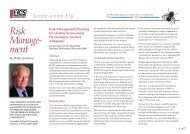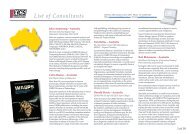Manual for Diagnosis of Screw-worm Fly - xcs consulting
Manual for Diagnosis of Screw-worm Fly - xcs consulting
Manual for Diagnosis of Screw-worm Fly - xcs consulting
You also want an ePaper? Increase the reach of your titles
YUMPU automatically turns print PDFs into web optimized ePapers that Google loves.
A <strong>Manual</strong> <strong>for</strong> the <strong>Diagnosis</strong> <strong>of</strong> <strong>Screw</strong>-Worm <strong>Fly</strong><br />
3. Description <strong>of</strong> life stages<br />
3.1 Adults<br />
Adult C. bezziana are metallic blue, bluish purple or blue/green in body colour with<br />
predominantly orange coloured heads and burgundy-coloured eyes (Plate 7). The hind<br />
margins <strong>of</strong> the abdominal tergites are black, giving the abdomen a slightly striped<br />
appearance which is more obvious in C. bezziana from Africa (see Fig. 31). In females the<br />
compound eyes are widely separated but in males, the eyes are virtually touching dorsally<br />
(Fig. 10). The frontal stripe <strong>of</strong> females is parallel sided and diagnostic <strong>for</strong> C. bezziana (Fig.<br />
10). The ovipositor and associated sclerites <strong>of</strong> C. bezziana are markedly shorter than closely<br />
related, similar-looking species <strong>of</strong> Chrysomya (see adult key).<br />
The size <strong>of</strong> adults varies, depending on the feeding regime during the larval stages. Body<br />
length is up to 10.0mm and head width up to 4.1mm.<br />
male female<br />
Figure 10: Head <strong>of</strong> male and female Chrysomya bezziana. Note that the compound eyes nearly<br />
touch in the male and both sexes have a marked “excavation” in the cheek area.<br />
3.2 Eggs<br />
The oval egg mass is brilliant white and firmly attached to the dry epidermis, or the exposed<br />
dermis adjacent to a wound or injury <strong>of</strong> the host animal (Plate 1). The eggs are glued to each<br />
other along their long axes with a dense secretion filling the spaces between the eggs which<br />
may be in three or more layers. The eggs are characteristically laid parallel to each other,<br />
giving the appearance <strong>of</strong> a shingled ro<strong>of</strong> (Fig.11). The individual eggs are difficult to separate<br />
from an egg mass without the use <strong>of</strong> chemical solvents such as dilute potassium hydroxide<br />
(KOH). Egg masses contain from 95 to 245 eggs (mean, 180) although, if a female is<br />
disturbed while ovipositing, two or more smaller egg masses may be deposited.<br />
10




